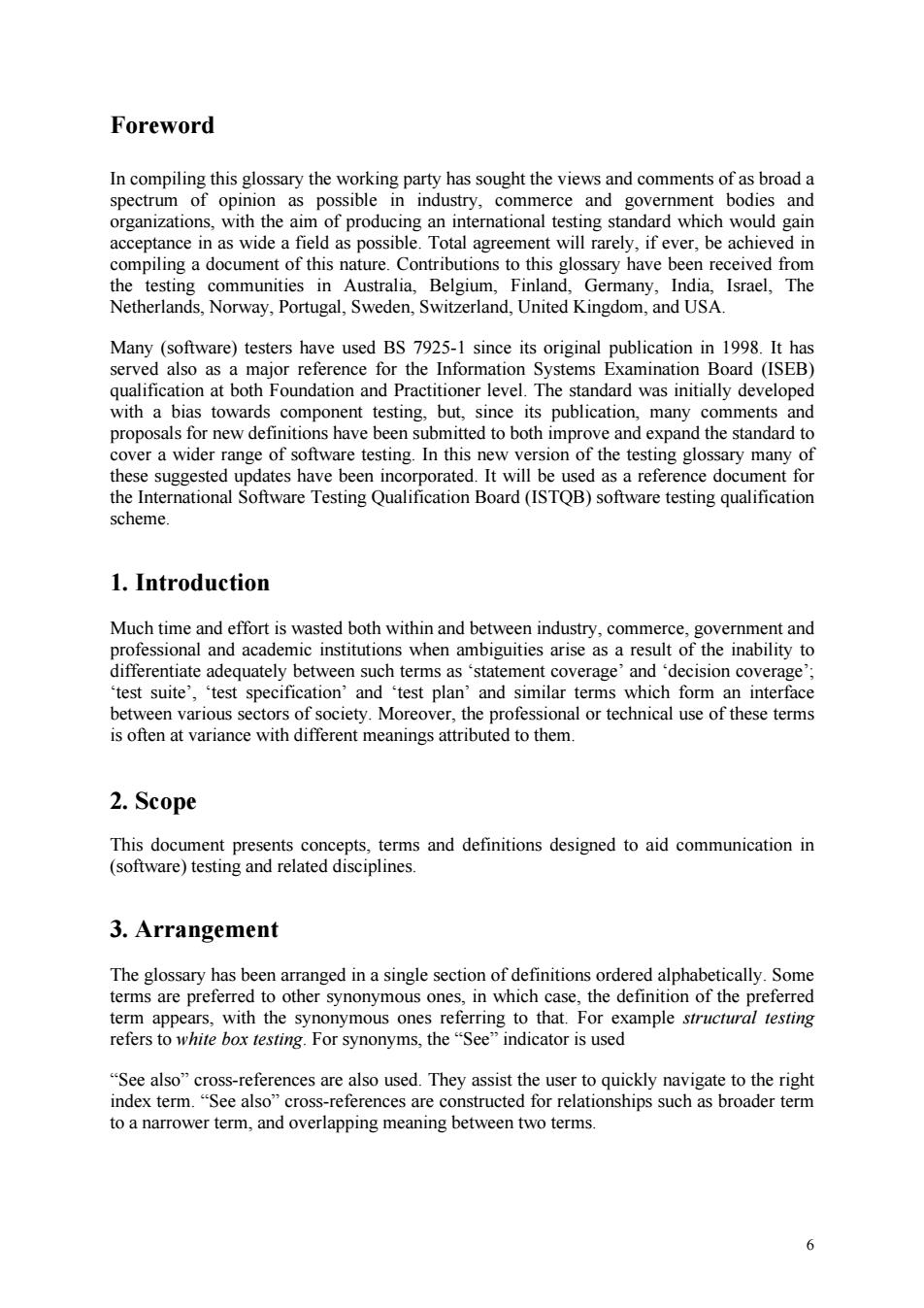正在加载图片...

Foreword In compiling this glossary the working party has sought the views and comments of as broad a spectrum of opinion as possible in industry,commerce and government bodies and organizations,with the aim of producing an international testing standard which would gain acceptance in as wide a field as possible.Total agreement will rarely,if ever,be achieved in compiling a document of this nature.Contributions to this glossary have been received from the testing communities in Australia,Belgium, Many (software)testers have used BS 7925-1 since its original publication in 1998.It has served also as a major reference for the Information Systems Examination Board (ISEB) qualification at both Foundation and Practitioner level.The standard was initially developed with a bias towards component testing,but,since its publication,many comments and proposals for new definitions have been submitted to both improve and expand the standard to cover a wider range of software testing.In this new version of the testing glossary many of these suggested updates have been incorporated.It will be used as a reference document for the International Software Testing Qualification Board (ISTQB)software testing qualification scheme. 1.Introduction Much time effort is wasted both within and b twee nindustry.comm Ce ambi s anse as a res he erage on hese ter is often at variance with different meanings attribu uted to them. 2.Scope This document presents concepts,terms and definitions designed to aid communication in (software)testing and related disciplines. 3.Arrangement The glossary has been arranged in a single section of definitions ordered alphabetically.Some terms are preferred to other synonymous ones,in which case,the definition of the preferred ee0ieaeargTomikeeaocapkwncmaei 4 See also” ss-references are also used They assist the user to auickly navigate to the right index term."See also"cross-references are constructed for relationships such as broader term to a narrower term,and overlapping meaning between two terms.6 Foreword In compiling this glossary the working party has sought the views and comments of as broad a spectrum of opinion as possible in industry, commerce and government bodies and organizations, with the aim of producing an international testing standard which would gain acceptance in as wide a field as possible. Total agreement will rarely, if ever, be achieved in compiling a document of this nature. Contributions to this glossary have been received from the testing communities in Australia, Belgium, Finland, Germany, India, Israel, The Netherlands, Norway, Portugal, Sweden, Switzerland, United Kingdom, and USA. Many (software) testers have used BS 7925-1 since its original publication in 1998. It has served also as a major reference for the Information Systems Examination Board (ISEB) qualification at both Foundation and Practitioner level. The standard was initially developed with a bias towards component testing, but, since its publication, many comments and proposals for new definitions have been submitted to both improve and expand the standard to cover a wider range of software testing. In this new version of the testing glossary many of these suggested updates have been incorporated. It will be used as a reference document for the International Software Testing Qualification Board (ISTQB) software testing qualification scheme. 1. Introduction Much time and effort is wasted both within and between industry, commerce, government and professional and academic institutions when ambiguities arise as a result of the inability to differentiate adequately between such terms as ‘statement coverage’ and ‘decision coverage’; ‘test suite’, ‘test specification’ and ‘test plan’ and similar terms which form an interface between various sectors of society. Moreover, the professional or technical use of these terms is often at variance with different meanings attributed to them. 2. Scope This document presents concepts, terms and definitions designed to aid communication in (software) testing and related disciplines. 3. Arrangement The glossary has been arranged in a single section of definitions ordered alphabetically. Some terms are preferred to other synonymous ones, in which case, the definition of the preferred term appears, with the synonymous ones referring to that. For example structural testing refers to white box testing. For synonyms, the “See” indicator is used “See also” cross-references are also used. They assist the user to quickly navigate to the right index term. “See also” cross-references are constructed for relationships such as broader term to a narrower term, and overlapping meaning between two terms